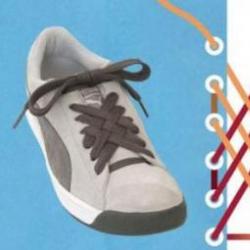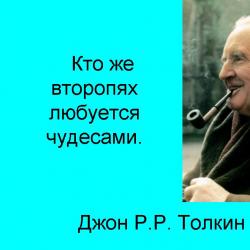We sew tapered trousers. How to sew trousers without a pattern with an elastic band, using old trousers. What is a base pattern and where to find it
It is impossible to sew trousers of a complex style without creating an individual pattern. However, it is quite possible to make simple bloomers in one evening. Fortunately, these wide-leg pants have been in fashion lately, and in combination with a fitted top they will look great on you. Bloomers will hide too full legs and give the image a special charm. In addition, similar clothes may be needed for oriental dance classes.
The basis of the future product will be a square piece of suitable fabric. The fabric for the summer should be perfectly draping, light: viscose, kashibo silk, satin. If you are preparing a dance costume or an oriental style outfit that you are going to wear with a skirt, it is acceptable to use chiffon.
Fold the square fabric in half along a diagonal line to form a scarf. The upper corner of the woven figure will be the waist line, the two lower opposite ones will be the slots for the legs. Trim and turn the hem of the waistband, form a drawstring and machine stitch it. Baste the connecting seam lines and machine stitch. All you have to do is thread the elastic band into the drawstring, remove the basting and steam the finished product.
Elasticated cuffs will add an oriental touch to summer trousers. For the drawstring, roll up the bottom of the trouser legs about 4 cm, stitch and thread the elastic band around the ankle. Sew open areas manually using a blind stitch.
Favorite pajamas instead of a pattern
Simple summer trousers can be made from elegant lightweight fabric using pajama pants of a suitable style as a basis. Carefully lay out a large piece of working fabric on a horizontal surface with the wrong side facing up, securing it at the corners with tailor pins - this will prevent the fabric from slipping. Place the pajama pants on top, then very carefully trace the back side of the product with a sharp piece of soap.
When transferring the contours of pajama pants directly onto the canvas, it is better to use a pointed soap instead of a tailor's chalk. You don’t have to worry about making mistakes when making extra lines on the fabric - all marks will come off during the first wash.
Do the same manipulations with the second piece of the cut - transfer the contours of the front of the trousers. Please note that the back of the pants will be slightly larger than the front. Cut out both main parts of the product and use a sewing machine to sew all connecting seams. Overcast the sections by hand or with an overlocker, and sequentially process the bottom and top hems.
All you have to do is insert the elastic into the drawstring and your summer outfit will be ready. It can be worn both at home and for everyday walks. The knitted product is perfect for sports activities.
For a century now, trousers have remained an important item in any woman’s basic wardrobe. This is a fairly durable item that can be combined with a lot of other clothes. And this significantly expands the range of images for everyday work and special occasions.
zarina.ru
Even if you have just begun to master the intricacies of sewing and have never taken on women’s or men’s pants, with detailed instructions it will be quite easy to fill this gap.
Sewing trousers with your own hands is quite simple if you immediately decide on a style that is in harmony with your body type.
Modern fashion has a wide range of interesting styles. For the first time, it is recommended to focus on the classic, straight type of trousers without pockets. They fit all body types, so anyone who sews can add their own original model to their wardrobe. Using this modeling method, it is possible to perform other types.
Modeling based on a classic trouser pattern
- Tight trousers with arrows.
- Low waist jeans.
- Flared pants.
- Pipe trousers.
- Trousers.
- Boyfriends.

befree.ru
Textile
The choice of fabric is the most important step before the main work of creating trousers, since the level of complexity of sewing will depend on the material. The process also takes into account the season of planned wear.
There is a conditional division of materials into two types: spring/summer and autumn/winter. For the first type, lightweight materials are suitable: linen, silk, cotton fabrics. For winter and autumn, it is preferable to take woolen and half-woolen ones.
Also, the fabric often dictates and conditions the style. For example, corduroy pants are more often used for sportswear, while at formal events classic noble natural materials (tweed, cashmere, angora) would be more appropriate.

alicdn.com
The amount of fabric needed to create trousers depends on two main criteria:
- clothing size;
- selected style.
There is also some advice when purchasing fabric. To avoid mistakes, add 25-30 cm to one length of the product for processing. Processing costs consist of the number of finishing fragments (pockets, belts, decorative elements). For the lining of trousers, it is customary to buy fabric equal to one length of the product.
Required measurements
- Waist circumference.
- Hip circumference.
- Seat height.
- Thigh height.
- Desired length of the product.
Take measurements with a measuring tape. All measurements, except seat height, are made while standing. The seat height is determined in a sitting position, taken from the surface of the chair or armchair to the waist.
Sewing trousers
For work, it is permissible to use an already formed drawing or take your purchased trousers and model a new product based on them. We have developed a master class in which trousers are sewn according to a ready-made pattern. However, for convenience, we present a version of the pattern for normal work with the drawing.

odensa-sama.ru
Materials and tools
- A pair of old trousers that fit you well.
- Paper.
- Pen.
- Scissors.
- Chalk or soap.
- Needles.
- Material according to size (about 2 m).
- Sewing machine.
- Rubber.
27.09.2018 13:00
Hello, dear craftswomen! Many girls think that sewing trousers is the most difficult task. This is wrong! Today we will tell you in detail how to sew trousers without a pattern, so that you can make yourself several different models.
- Pants for going out!
- How to sew bloomers
- Pants with elastic
- The most comfortable pants
Pants for going out!
Why not! Knowing all the secrets of this procedure, you can make them yourself, even without a pattern.
Get pants that fit you well.
How to translate before:
What allowances to make:
- along the middle, step, side seams - 1.5 cm
- at the bottom - 3.0 cm
- waist - 1.0 cm
- leave 4.0 cm for the fastener
Adjust the measurements in the drawing to your parameters (hip, waist), then cut out.
To be sure, transfer the details first onto paper and then onto the material.
Let's start sewing
After trying on, make the necessary changes.
How to sew bloomers
To quickly sew harem pants (shalwars), take a square piece of fabric. It can be silk, viscose, kashibo or satin.
Fold the fabric in half diagonally to form a triangle-shaped scarf. There will be a waist line in the upper corner. At the bottom there are slots for the legs.
Make a mark according to your waist size, cut off the top part of the “kerchief”. Sew the side seams, turn the top, stitch, insert elastic or sew on a waistband. Sew cuffs onto the leg openings. Shalwars with elastic are ready!
Pants with elastic
Summer pants can be made in one evening:
Using this pattern you can make wide pants.
Pattern for beginners: step by step
Women's trousers can be made using comfortable jeans.
How to sew:
- Sew the darts.
- Baste the front and back pieces.
- Sew the step seams, then move on to the side seams. Don't forget that there will be a zipper sewn in front.
- Cut the waistband (for rigidity, lay interlining on the inside). The length is determined by the waist, and the width will be 7-10 cm.
- Make a buttonhole. Sew on the belt.
Chic trousers for summer holidays
These can be beach models or for a walk around the city. If you choose a light, expensive fabric, you may get an evening option.
The secret to success is drapery and skillful scent. It is better to sew wraparound trousers from draping fabrics.
First, let's make a paper pattern: (1 square = 5.5 cm).
Let's start cutting:
- Half trousers with a fold – 2 parts$
- 4 ties: length 40 cm - width 6 cm (3 cm ready-made).
Allowances:
- Leave 1 cm for the middle seam, 2 cm for the top cut and bottom, and 1.5 cm for the remaining cuts.
Operating procedure:
- Place the trouser halves right sides together and sew the middle seam. Sew the seam allowances together, press to one side from the top edge, continuing until the beginning of the step.
- There is no need to iron the allowances in the rounding area.
- Turn the seam allowances on the top and bottom edges inside out, turn them under, and topstitch.
- Fold each tie lengthwise. Cut one end on the bias.
- Stitch along longitudinal and oblique cuts.
- Turn it inside out and stitch to the edge.
- Sew the ties to the longitudinal sections at the upper ends, turn them over the stitching seam.
- Put on the new thing, tie the ties of the front halves in the back, and the back ones in the front. Can be done with Velcro.
Using this pattern you can make leggings.
The most comfortable pants
A trouser skirt can be tailored using a pattern of regular trousers.
If you chose a fabric with a width of 1.4 m, then take 2 lengths plus 4 cm for the upper and lower sections.
When modeling a version with 2 folds, cut both parts of the pattern in the middle, spreading them apart by 16 cm, and with three folds, then by 24 cm.
In the lower part, the width of the fold is reduced by 3 cm at both ends, then the resulting points on the lower cut of the product are connected to the points where the fold intersects with the hip line.
If the flare is only at the bottom, then use this pattern, closing the upper darts, making a cut along the dart line.
Long trouser skirt model made of light flowing fabrics.
Finally: Without wasting a minute, sit down at the machine to make a new wardrobe item, and you already know how to sew trousers without a pattern.
Hello, my dear readers of the blog “site”. Now we will sew fashionable trousers with a low seat line and 7/8 length.
The following ready-made pattern for downloading is designed for the following sizes:

- St=38
- Sat=50
- Height to knee from waist=56
- Half knee circumference=22
- Pants width at the bottom = 33 cm (for narrow calves)
- Pants length 93 cm.
If you fit the hips, then you can adjust the rest of the measurements.
If you want to build trouser pattern for yourself, be sure to read these two articles:
They walk you through the whole process step by step. constructing trouser patterns according to the measurements you took.
Download the pattern and cut out the parts from the fabric. I sew from non-stretch suit fabric. You can take any suit or denim, according to your desire.






We cut out the details of the pocket and the slope (it will need to be built using a codpiece pattern). Let's look at this point a little later.




We connect both halves of the trousers (front and back) from knee reference point first up, then down. We fasten with pins or baste.


We machine sew both halves of the trousers. This is what you should get:


Now we will process the bottom of the trousers. Initially, I placed 2 cm allowances at the bottom so that 1 cm could be folded twice. First turn up the bottom of the trousers by 1 cm. Let's iron this place.
Then we turn it in another 1 cm. Iron it.
Once again, iron the finished bottom of the trousers.


Now you need to process the zipper in the trousers and make a belt.


We sew the belt to the trousers using a machine.
We turn the belt inside out so that both parts (outer and inner) are face to face. Now you need to sew up the sides of the belt so that they smoothly merge into the codpiece. We baste and stitch the sides of the waistband along the allowance line. (as in the photo on the right)




Now we bend the allowances to the side of the belt and tuck the allowances of the inner belt so that the inner belt slightly covers the seam of attaching the belt to the trousers. It is advisable to redraw this seam by 2 mm, then you will get a neat inner part of the belt.


Now the important point. We sew from the front side into the seam of attaching the belt to the trousers. This way we will sew the inner belt to the outer one, and all the allowances will remain inside, and there will be a beautiful inner trim of the trousers.
It’s just very important to hit this seam exactly. To do this, we move the belt and the trousers themselves apart (as if we pull them) in different directions. Then we will iron the belt and this line will not be visible if you do everything carefully.






But there are not enough loops on the belt where we can put the belt.


Now it's time to make a loop and sew a button on the trousers.
To do this, we will use a special buttonhole foot. We insert our button into the foot, put the foot into the machine. Don't forget to lower the special thing down so that it stops the machine's progress and points it in the opposite direction.
The machine has a special loop mode, as in the photo below.
And of course, do not make a buttonhole on your trousers right away, but practice first several times on the same fabric with which you are sewing your trousers. Since the loop may need to be adjusted.


We made a loop on the trousers.


And they sewed on a button.




P.S. Although I built them for myself, I wanted them to have a low seam (I lowered the seat line by 5 cm from the natural one), but this turned out to be too much in the finished product. This may depend on the quality and density of the fabric. In any case, you can adjust this moment if necessary (hem the excess from the inside).
Watch also a video about how to sew new trousers without a pattern, using your favorite ones as a basis old pants:
I hope you liked the article and if you sewed trousers, they will bring you many joyful moments!! Sew with me!
In this article you will not find a detailed description of how to sew trousers, but you will learn a lot of useful tips on how to sew women's or men's trousers with your own hands.
It is impossible to give complete technology and detailed processing of sewing trousers within one article. In other articles on the site you can find a detailed description of each operation separately, for example, how to hem trousers, process the waistband of trousers, process pockets, cuts, the bottom of trousers with cuffs, etc. That is why in this article we offer only a list of technological operations related to sewing trousers available on website.
All these recommendations can be used when sewing not only women's or men's trousers. They will also come in handy when sewing summer trousers with elastic for your child, children's trousers for a boy or a girl. Much can be used even when sewing jeans or denim skirts. In any case, these articles will help beginner tailors sew trousers correctly.

Trousers can be cut from 120-130cm fabric, 150cm wide. However, for the cut of loose-fitting trousers, this norm can double exactly.
.

If you decide to sew trousers with your own hands, then the first thing you have to decide is to find a suitable pattern. In many magazines and online resources you can find ready-made patterns. However, before cutting expensive fabric, you must first check them, since almost all designs are designed for a standard figure. And many of them contain elements of outdated cut that are not used in modern clothing, since they were scanned from textbooks of the 50s.
Processing the upper cut with a stitched belt

The belt for men's trousers is made with belt loops and reinforced with bodice braid. However, for women's trousers, summer trousers with elastic or children's trousers, you can use this simplified method of processing a belt.
.
Video on how to make buttonholes on a trouser waistband using a sewing machine in four steps.

The most difficult thing for a beginning seamstress is to properly process the codpiece, and it is especially difficult to sew in a zipper. Read this article, it contains many detailed photos that explain step by step how to perform this processing. Despite the fact that the article was written for a master class on sewing a skirt, it can also be used when sewing women's trousers.
.
Processing belt loops

Processing belt loops for women's trousers.
Processing patch pockets

Pockets on the front halves of women's trousers are often made with welts (in a frame, with a leaf) or placed in the side seams. But sometimes, depending on the model of trousers, it is necessary to make not only back, but also front patch pockets.
Framed welt pocket and flap pocket

Hemming the bottom of men's trousers

Processing the hem of the bottom of men's trousers is most often the final sewing operation, but this is precisely what can be difficult to do with a neat and invisible stitch. Read the advice of an experienced studio technologist in the article Processing the hem of the bottom of trousers.
You can hem trousers or a skirt on a regular sewing machine using a special foot. This video shows how to do this.
Processing the hem of the bottom of trousers with a cuff

For children's trousers, especially trousers for boys, it is better to hem the hem with a cuff. Boys grow quickly and within a year you can rip out the cuffs and lengthen the trousers by 3-4cm without a trace of ironing.
See How to Double Cuff Pants.

Standard processing technology for men's trousers. In the article you will find a lot of useful information for beginners learning to sew trousers and skirts.
Processing technology for men's trousers.

Hidden zippers are rarely used on trousers, but if your model has one, this article will help you sew a zipper correctly.
See also .
Ways to sew a zipper into a skirt

How to sew different types of zippers. Simple and accessible technology for everyone.
How to simply and accurately sew in a zipper.
Wet-heat treatment of trousers

Wet-heat treatment is one of the components of high-quality tailoring of trousers. This especially applies to sewing men's and women's trousers from suiting and woolen fabrics.
To sew trousers beautifully and neatly with your own hands, you must constantly use a steam iron. Iron and straighten the seams in a timely manner, adjust the fabric if necessary, or, conversely, stretch it, etc.
This video clearly shows how to mark and make a dart for a skirt or trousers.






